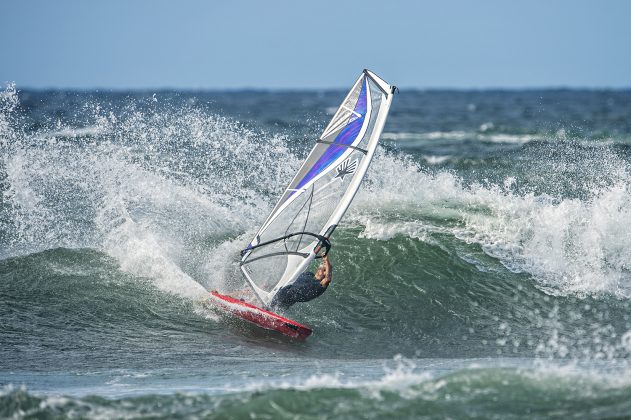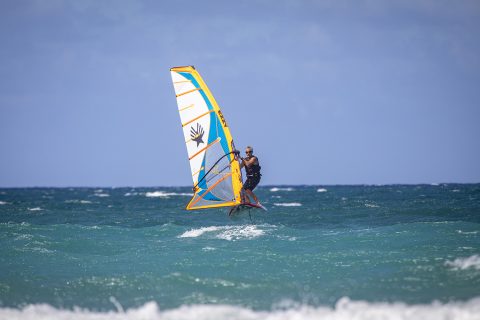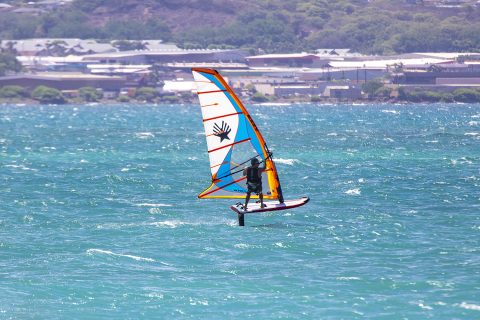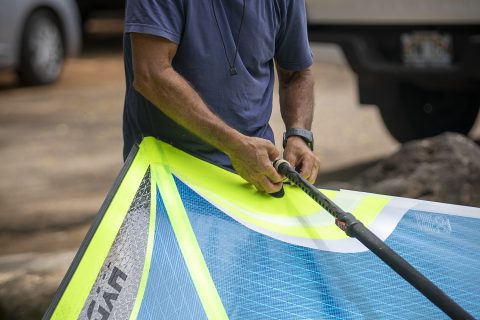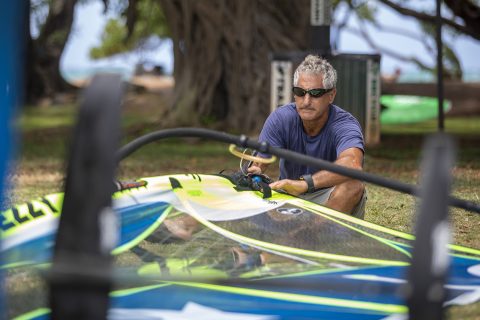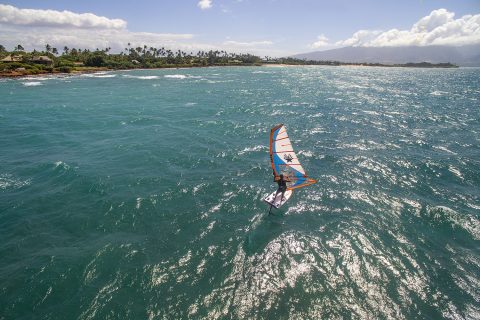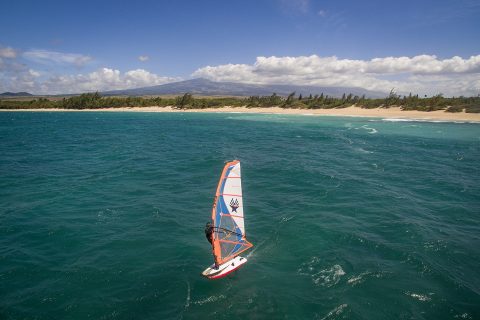David Ezzy is one of windsurfing’s pioneers; a Ho’okipa stalwart who has built a brand around his passion for windsurfing and obsession with quality. From sailing the biggest days to designing innovative sails, everything is done with pure dedication to his craft. His son, Graham Ezzy, gives us a candid insight into David’s life.
Words Graham Ezzy, David Ezzy & Josh Angulo // Photos Kevin Pritchard, Sofie Louca/Fish Bowl Diaries
My father is a serious man. Ever since I was a little kid, he has had the same daily routine. He wakes up in the dark at 3 o’clock in the morning. In these quiet hours of night, he works behind his computer designing windsurfing sails. At sunrise, he starts a 2 hour exercise routine. After that, when I’m waking up, he eats breakfast. He works a bit more, and then goes windsurfing in the afternoon. He brushes his teeth after every meal. And he is in bed before 21:00. This is his life every single day of the year. My father is David Ezzy, a pioneer of windsurfing and founder of Ezzy Sails.
He’s not religious, but people often think that he is because of his ascetic life. There’s not much time for socializing when you wake up at 3 every morning. His dedication to sail making is a kind of religion, and it has not left room for much else in his life. He’s the kind of man who would rather do things the hard way because that feels more right than something easier, even if the results are the same.
- Click to Enlarge
- Click to Enlarge
PRINCIPLES AND PASSION
But that’s not the whole story. His soul is stretched between principles and passion. His love for windsurfing is a blinding, life-changing love. He dropped out of his final year of university to move to Hawaii to follow his windsurfing dreams. He gave everything up to do so. His own father was so disappointed that he stopped speaking to David for years.
David grew up in western Canada, and he loved freedom. His heart was in ski racing, flying down the icy hills alone, until he found windsurfing as a teenager, and that became all he wanted to do.
He lives a highly disciplined life, and he expects his kids to live the same. Yet, he never put any pressure on us. He would constantly tell me growing up, “You have to find what you love to do, and then do that thing for your job. Don’t do what you think I want you to do. If you want to windsurf, do it. If you want to do something else, do that thing instead.” He is a man of strong beliefs and passions, and that has made him both enemies and very loyal friends. There is a story that Kai Hopf told me years ago that I think captures a lot about David. Kai is the sail designer who replaced my dad at North Sails in the 90s and who now designs for Duotone. Back when Kai first moved to Maui, during one of his first Ho’okipa sessions when the waves were big, Kai’s rig broke. Kai was stuck swimming in the current and about to get smashed on the rocks. David was on the beach watching, and he swam out to rescue Kai. When Kai told me the story he said, “He saved me, I couldn’t believe it. But it took him another 2 years to say hello to me.”
That story shows a lot of what I saw in my dad when I grew up: he was always driven to do the right thing, even if it meant risking his own life, but there was no guarantee he would be friendly. Discipline, passion, and freedom are not natural bedmates, but they are the driving forces inside my dad. Having such opposite impulses could drive someone crazy, but for David, it pushed him into windsurfing, which is a sport that is technical and difficult, but at its heart about being free.
CANADA TO KAILUA
For over 45 years, windsurfing has guided the life of David Ezzy. Nowadays, his passion is spent on foiling, his latest obsession – and he foils every single day on Maui. I wanted to know more about my father’s journey, so I called him up, and this is what he said. “I was skiing at Whistler, Canada in the summer of 1973. I had never heard of windsurfing. My ski coach said you’ve got to try this. We went to Alta Lake, and I got on a windsurfer. And from that day, I was addicted. I got in my car with the windsurfer strapped on top, and I drove down to Baja. I didn’t have any maps. I didn’t know where I was going. I just drove, and if I found water, I would windsurf. I spent most of my time in San Francisco windsurfing in the bay.
Shortly after that, I saw a picture of windsurfing on Oahu, and it looked like paradise. I flew there in ’77, and I expected the airport to be right on the beach, but Honolulu was the same as it is now, a concrete jungle. We got a ride to Kailua, right to the beach. The wind and the air were the most amazing thing that I had ever experienced – thick and warm. And the water was beautiful blue. I got a job cleaning carpets. We didn’t have a car, but we lived right on the beach, and I would windsurf to work. Kailua was full of guys who totally innovated our sport. Nobody now knows their names, but if it weren’t for them, windsurfing would not be what it is today.
These guys made raked back, smaller dagger boards that allowed the board to stay in the water. They took the plastic boards and left them in the sun and would bend the nose to give them scoop. They cut the tails off stock windsurf boards. They made the double-T universal joint.
Pat Love made the first custom windsurfing sails that were basically the same 8’6” boom as the original windsurfer, but with a shorter luff that allowed you to sail in stronger wind. He was my idol. I was on Oahu in ‘78, and I decided that I should go back to university and study chemistry back in Canada. When I went back to Oahu a couple years later, windsurfing had gone from being a flat water form of dinghy sailing to something radical. Hugh England put a mast track in a surfboard, and everybody wanted to see if they could ride it. By today’s standards, it would be very narrow, but you’d be able to ride it. But back then it seemed impossible. For me, that opened my eyes to the potential of going smaller.
We were living in a house with a lot of people, and we were making custom boards behind our house. Our neighbours would complain because we’d have the machines going at night and the police would come. We were sailing Diamond Head. It was a lot of fun. l saw a picture of Mike Waltze sailing Ho’okipa in a slideshow put on by Steve Wilkings. I had never seen anyone ride such radical waves on a windsurfer. I moved to Maui the next month, and I have lived there ever since. That was in 1981.
- Click to Enlarge
- Click to Enlarge
MAUI
Ho’okipa was better than anything I could have imagined. I became obsessed with riding waves on a windsurfer and doing carving turns on big waves. I didn’t miss a day at Ho’okipa for 30 years.
When I first moved to Maui, I lived with Malte Simmer in a house with a bunch of other young windsurfers. He had been working for Maui Sails, and he had just left to start his own sail company, Simmer. I was intrigued with sail making, and I made a deal with Malte that I would work for him for a year without getting paid if I could learn and start my own sail business.
I started Ezzy Sails in ’83 in an old chicken coop in Haiku. That was back in the custom sail days. Before production sails were really a thing. I renovated the building and started sewing sails. I had just enough money to buy one sewing machine and 3 rolls of cloth – white, red, and blue. I made the first sail for the guy who helped me renovate the building. And then I just started selling sails. In 1984 I sold 3500 sails in Japan alone.
Craig Masonville was a friend of mine and an amazing guy. We owe so much to Craig. He started Hi-Tech in Paia. He lived in the back, sleeping next to his work bench. We were trying to figure out how to make a board that would be stiffer on the bottom turn and looser off the top. I had a swallow tail, and we had the idea to cut off one of the swallows. That was the first asymmetrical in windsurfing. Then Craig came up with the can-opener board. It was a board he made for me. He would sometimes make 5 boards a week for testing. That’s how we progressed so quickly with the development.
NORTH SAILS
When North Sails started to make windsurfing sails, Ken Winner recommended me to design their wave sails. Eckart Wagner hired me in ‘85. It was right when Australia beat the US in the America’s Cup, and there was so much new energy going around in sail design. I got to meet the yacht designers. North had a sophisticated computer program for designing sails, and I got a portable computer from North that looked like a suitcase. It was like going back to school. Eckart built the North factory in Sri Lanka.
Eckart really had foresight. He saw that Sri Lanka had the highest literacy rate of the Asian countries doing manufacturing then. They built the factory with elephants, and I think the North group thought he was crazy. I really enjoyed working with Eckart and the whole team. We had a great group of people working with us – Dave Kalama, Mark Angulo, and the list goes on. Eckart eventually sold his shares and left North. At this time I was on the board of directors of North Windsurfing. I was designing most of the sails, and we were doing the promotion and pictures on Maui.
EZZY SAILS AGAIN
Eckart was no longer with North, and I met him in San Diego during the America’s Cup. I explained that I wanted to start my own business, and Eckart scribbled on a piece of paper 3 important secrets I needed to do to be successful. I did not know where I was going to make sails. I travelled to China and went to a factory. They were efficient but it seemed very robotic. There was not a lot of talking. It didn’t seem like a happy place to work. Then I went to Sri Lanka, and I stayed with a friend who has a factory. One evening, they told me, “There’s a Sri Lankan guy here to see you.” And it was Augustine, one of the workers from the North Factory. He told me, “We want to start a factory with you.” At that time he was still working for North, and that gave me the idea to start my own factory. Thirty of the workers from North Sails came with me. The North management was really angry, but it was not my decision. The workers came to me. Back then, I didn’t even want to own a factory. We didn’t have much money, but we found an old, tiny building, more like a horse stall, to start making sails.
Even back then, I was obsessed with quality, so we rigged every sail in the factory to inspect them before shipping. It was a lot of work. The workers were amazing and the reason we survived. I remember one big order that we did not think we could finish on time. I stayed in the factory till late and then said that we should should all go home and start fresh tomorrow. And when I came back in the morning, the core team was still there. They had worked all night. I didn’t tell them to, in fact, I told them to go home, but they stayed all night to get it right. That factory was a terrible, small building. We didn’t even have a phone. We went a whole year without a phone. We had to use the manager’s house phone for the fax. No phone, no fax, nothing. I can’t figure out how we did it, but we made great sails. We eventually moved to a better location, and we built our own factory, which we are still in. And the core group of people is still the same from when we started. I have seen their kids be born, go to school, go to college. One of those kids is now working for us. It is like a family for me.
- Click to Enlarge
- Click to Enlarge
FOILING
For a long time, my enjoyment with windsurfing mainly came from testing sails. I tried foiling like two years ago. It was like windsurfing the first time all over again, except maybe better. I am in that same sort of developmental mode, learning mode, as when I was 20.” – David Ezzy.
JOSH ANGULO
I reached out to windsurf legend and multiple world champion Josh Angulo for a story about David, and this is what he told me “During one of my dark eras, when I battled with alcohol and drug abuse, David took me into his house to live with him and his family. I was a team rider for Ezzy Sails, but our relationship went beyond that. While I was living with him, the deal was that we would wake up early to go training, do chores, and eventually go sailing at Ho’okipa. At this time I was the young, cool, badass Maui guy who knew all the hardcore locals. I would roll up to the beach with David Ezzy, who was a super straight shooter. But that was not bad because he is a highly respected sail maker and was a solid ripper in the Ho’okipa lineup.
But what was bad and totally hilarious was this: David is super intense in whatever he does, and his morning runs were long and hard, and he’s super fit. He ran with no shirt and in tiny, dove jogging shorts. He convinced me that to run right, I also needed to wear these flimsy revealing dove jogging shorts without a shirt for less resistance. So there I was, running with David Ezzy, feeling practically naked in these shorts on the main Haiku roads where everybody drives. What were all the tough guys going to think about me!
On our runs, I would be huffing and puffing but getting stronger every day, and when we got to a big hill, David would yell at me, “If you can’t make it up the hill, how will you stop doing drugs?“ And I would push myself up the hill. Life progressed and I’m now many years clean. I went on to fulfil my dream of winning a couple of world titles in part thanks to David and many other people. Many years later, in my training for contests and other life challenges, I tell myself, “If I can not get up this hill, how can I do anything hard.” That is the great life lesson I learned while running the hills of Haiku in funky little jogging shorts with the great David Ezzy.” That’s what I love about my dad – always running up hills, not caring about how he looks, and not willing to leave anyone behind. – Graham Ezzy.

